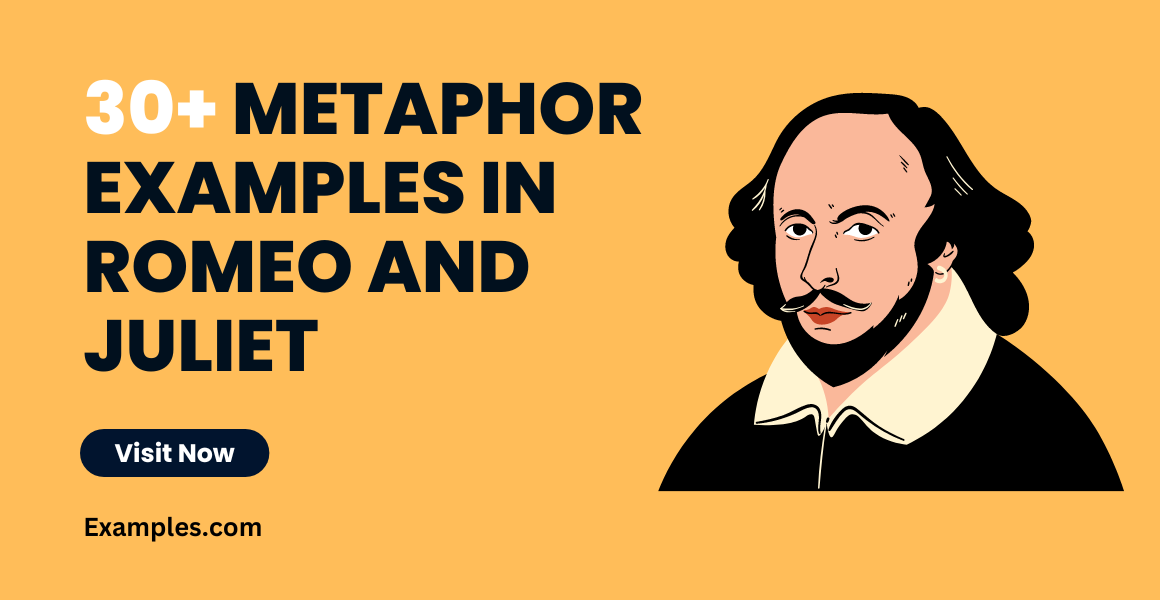6+ Metaphor in Romeo and Juliet Examples
In William Shakespeare’s tragic play “Romeo and Juliet,” metaphors are used extensively to add depth and emotion to the story. These metaphor examples not only convey the intense love and passion between the two main characters but also depict their struggles and fate. They enhance the poetic language and symbolism throughout the play, helping readers and viewers to connect with the timeless themes of love, destiny, and conflict. The following examples highlight some of the standout metaphors in this iconic piece of literature.
What is the Best Example of Metaphor in Romeo and Juliet?
Perhaps one of the best and most famous examples of metaphor in “Romeo and Juliet” is found in Act 2, Scene 2, known as the balcony scene. In this scene, Romeo compares Juliet to the sun, saying:
“But, soft! What light through yonder window breaks? It is the east, and Juliet is the sun.”
This metaphor not only encapsulates the passion and ardor that Romeo feels for Juliet but also conveys her importance to him. By likening Juliet to the sun, Romeo elevates her above everything else, emphasizing her warmth, light, and the way she illuminates his life. It’s a powerful metaphor that resonates with the theme of transcendent love that runs throughout the play.
Metaphor in Romeo and Juliet Act Scenes

Metaphor in Romeo and Juliet Act 1
Scene 1
– “Love is a smoke raised with the fume of sighs.” (Romeo)
– “Being vexed, a sea nourished with lovers’ tears.” (Romeo)
– “What is else? A madness most discreet.” (Romeo)
Scene 2
– “One fire burns out another’s burning.” (Benvolio)
Scene 4
– “Love’s wings” (Romeo)
Scene 5
– “You have dancing shoes / With nimble soles.” (Romeo)
Metaphor in Romeo and Juliet Act 2
Scene 2
– “Arise, fair sun, and kill the envious moon.” (Romeo)
– “O, speak again, bright angel!” (Romeo)
– “This bud of love, by summer’s ripening breath, may prove a beauteous flower when next we meet.” (Juliet)
– “Two of the fairest stars in all the heaven.” (Romeo)
Scene 3
– “The earth that’s nature’s mother is her tomb.” (Friar Laurence)
– “Dew-dropping south” (Friar Laurence)
Scene 6
– “These violent delights have violent ends.” (Friar Laurence)
Metaphor in Romeo and Juliet Act 3
Scene 1
– “Fire-eyed fury be my conduct now!” (Romeo)
Scene 2
– “Lovers can see to do their amorous rites by their own beauties.” (Juliet)
– “Beautiful tyrant! Fiend angelical!” (Juliet)
– “Dove-feathered raven, wolfish ravening lamb.” (Juliet)
Scene 5
– “I must be gone and live, or stay and die.” (Romeo)
Metaphor in Romeo and Juliet Act 4
Scene 1
– “As rich shall Romeo’s by his lady’s lie; poor sacrifices of our enmity!” (Capulet)
Scene 3
– “Shall I not, then, be stifled in the vault.” (Juliet)
– “And I, this three hours’ wife, have mangled it.” (Juliet)
Scene 5
– “Death is my son-in-law, Death is my heir.” (Capulet)
– “Death lies on her like an untimely frost.” (Capulet)
Metaphor in Romeo and Juliet Act 5
Scene 1
– “I defy you, stars.” (Romeo)
– “Is it even so? Then I defy you, stars!” (Romeo)
Scene 3
– “Death’s pale flag is not advanced there.” (Balthasar)
– “With worms that are thy chamber-maids.” (Romeo)
– “Thou detestable maw, thou womb of death.” (Romeo)
– “Flattering truth of sleep.” (Paris)
How Shakespeare used Metaphors in Romeo and Juliet
These metaphorical expressions contribute greatly to the understanding of characters, themes, and emotions in the play, adding depth and texture to the tragic love story. You may also See Metaphors in PDF.
Shakespeare’s use of metaphors in “Romeo and Juliet” is integral to the understanding of the characters and the themes that are central to this tragic love story. Here’s an analysis of the significance of metaphors in the play:
- Expression of Emotion: Shakespeare uses metaphors to give voice to the intense and often conflicting emotions of the characters. For instance, Romeo’s comparison of Juliet to the sun (“Arise, fair sun, and kill the envious moon”) conveys his passion and the way Juliet illuminates his world.
- Character Development: Through metaphor, Shakespeare provides insight into the characters’ personalities and their states of mind. Juliet’s description of Romeo as a “beautiful tyrant” and “dove-feathered raven” captures her confusion and conflict when she learns of Tybalt’s death at Romeo’s hands.
- Enhancement of Themes: Metaphors contribute to the understanding of the major themes of the play, such as love, fate, youth, and death. The metaphor “These violent delights have violent ends” speaks to the play’s overarching theme of the fleeting nature of passionate love.
- Poetic Beauty: The use of metaphor adds a poetic quality to the dialogue, enhancing the aesthetics of the play. It elevates the language, making it more vivid and resonant, as in Romeo’s line, “Love is a smoke raised with the fume of sighs.”
- Symbolism and Imagery: The metaphors often carry symbolic meanings that resonate throughout the play. The repeated metaphor of stars and celestial imagery, for instance, underscores the idea of destiny and the cosmic forces at work in the characters’ lives.
- Contrast and Paradox: Shakespeare often employs metaphors to highlight contrasts and paradoxes within the story, as with Juliet’s juxtaposition of a “dove-feathered raven” and “wolfish ravening lamb.” These metaphors capture the complexity and ambiguity of love and human nature.
- Connection to Elizabethan Audience: The use of familiar metaphors and imagery would have helped Shakespeare’s contemporary audience connect with the play’s universal themes. They would have understood the symbolism and references within the metaphors, making the play more accessible and resonant.
In summary, the metaphors in “Romeo and Juliet” are not mere decorative elements but essential tools that Shakespeare employs to deepen the audience’s understanding of the characters and the story. They add richness, complexity, and beauty to the text, and their thoughtful and creative use is a testament to Shakespeare’s genius as a writer.


